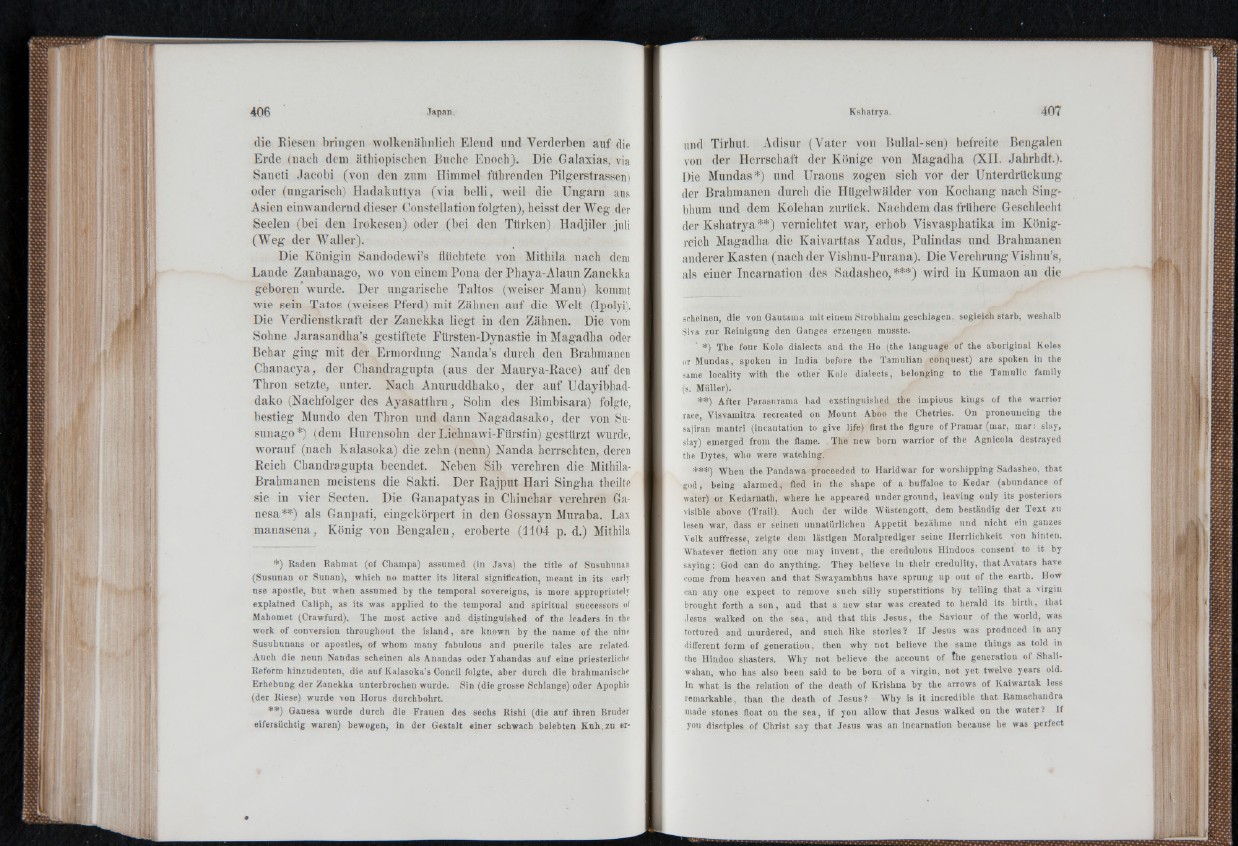
die Eiesen bringen wolkenähnlich Elend und Verderben auf die
Erde (nach dem äthiopischen Buche Enoch). Die Galaxias, via
Sancti Jacobi (von den zum Himmel führenden Pilgerstrassen)
oder (ungarisch) Hadakuttya (via belli, weil die Ungarn aus
Asien einwandernd dieser Constellation folgten), heisst der Weg der
Seelen (bei den Irokesen) oder (bei den Türken) Hadjiler juli
(Weg der Waller).
Die Königin Sandodewi’s flüchtete von Mithila nach dem
Lande Zanbanago, wo von einem Pona der Phaya-Alaun Zanekka
geboren wurde. Der ungarische Taltos (weiser Mann) kommt
wie sein Tatos (weises Pferd) mit Zähnen auf die Welt (Ipolyi).
Die Verdienstkraft der Zanekka liegt in den Zähnen. Die vom
Sohne Jarasandha’s gestiftete Ftirsten-Dynastie in Magadha öder
Behar ging mit der Ermordung Nanda’s durch den Brahmanen
Chanacya, der Chandragupta (aus der Maurya-Kace) auf den
Thron setzte, unter. Nach Anuruddhako, der au f Udayibhad-
dako (Nachfolger des Ayasatthru, Sohn des Bimbisara) folgte,
bestieg Mundo den Thron und dann Nagadasako, der von Su-
sunago *) (dem Hurensohn der Lichnawi-Fürstin) gestürzt wurde,
worauf (nach Kalasoka) die zehn (neun) Nanda herrschten, deren
Reich Chandragupta beendet. Neben Sib verehren die Mithila-
Brahmanen meistens die Sakti. Der Rajput Hari Singha theilte
sie in vier Secten. Die Ganapatyas in Chinchar verehren Ga-
nesa **) als Ganpati, eingekörpert in den Gossayn Muraba. Lax
manasena, König von Bengalen, eroberte (1104 p. d.) Mithila
• ) Raden Rahmat (of Champa) assumed (in Java) the title of Susnhunan
(Susunan or Snnan), which no matter its literal signification, meant in its early
use apostle, but when assumed by the temporal sovereigns, is more appropriately
explained Caliph, as its was applied to the temporal and spiritual successors of
Mahomet (Crawfurd). The most active and distinguished of the leaders in the
work of conversion throughout the islan d , are known by the name of the nine
Susuhunans or apostles, of whom many fabulous and puerile tales are related.
Auch die neun Nan das scheinen als Anandas oder Vahandas auf eine priesterliche
Reform hinzudeuten, die auf Kalasoka’s Concil folgte, aber durch die brahmanische
Erhebung der Zanekka unterbrochen wurde. Sin (die grosse Schlange) oder Apophis
(der Riese) wurde von Horus durchbohrt.
**) Ganesa wurde durch die Frauen des sechs Rishi (die auf ihren Bruder
eifersüchtig waren) bewogen, in der Gestalt einer schwach belebten Kuh. zu erund
Tirhut. Adisur (Vater von Bullal-sen) befreite Bengalen
von der Herrschaft der Könige von Magadha (XII. Jahrhdt.).
Die Mundas*) und Uraons zogen sich vor der Unterdrückung
der Brahmanen durch die Hügelwälder von Kochang nach Sing-
bhum irnd dem Kolehan zurück. Nachdem das frühere Geschlecht
der Kshatrya**) vernichtet war, erhob Visvasphatika im Königreich
Magadha die Kaivarttas Yadus, Pulindas und Brahmanen
anderer Kasten (nach der Vishnu-Purana). Die Verehrung Vishnu’s,
als einer Incarnation des Sadasheo, ***) wird in Kumaon an die
scheinen, die von Gautama mit einem Strohhalm geschlagen, sogleich starb, weshalb
Siva zur Reinigung den Ganges erzeugen musste.
*) The four Kole dialects and the Ho (the language of the aboriginal Koles
or Mundas, spoken in India before the Tamulian conquest) are spoken in the
same locality with the other Kole dialects, belonging to the Tamulic family
(s. Müller).
**) After Parasurama had extinguished the impious kings of the warrior
race, Visvamitra recreated on Mount Aboo the Chetries. On pronouncing the
sajiran mantri (incantation to give life) first the figure of Pramar (mar, mar: slay,
slay) emerged from the flame. The new born warrior of the Agnicola destrayed
the Dytes, who were watching.
*##) When the Pandawa proceeded to Haridwar for worshipping Sadasheo, that
god, being alarmed, fled in the shape of a buffaloe to Kedar (abundance of
water) or Kedarnath, where he appeared under ground, leaving only its posteriors
visible above (Trail). Auch der wilde Wüstengott, dem beständig der Text zu
lesen war, dass er seinen unnatürlichen Appetit bezähme und nicht ein ganzes
Volk auffresse, zeigte dem lästigen Moralprediger seine Herrlichkeit von hinten.
Whatever fiction any one may invent, the credulous Hindoos consent to it by
saying: God can do anything. They believe in their credulity, that Avatars have
come from heaven and that Swayambhus have sprung up out of the earth. How
can any one expect to remove such silly superstitions by telling that a virgin
brought forth a son , and that a new star was created to herald its birth, that
Jesus walked on the sea, and that this Jesus, the Saviour of the world, was
tortured and murdered, and such like stories? If Jesus was produced in any
different form of generation, then why not believe the same things as told in
the Hindoo shasters. Why not believe the account of the generation of Shali-
wahan, who has also been said to be born of a virgin, not yet twelve years old.
In what is the relation of the death of Krishna by the arrows of Kaiwartak less
remarkable, than the death of Jesus? Why is it incredible that Ramachandra
made stones float on the sea, if you allow that Jesus walked on the water? If
you disciples of Christ say that Jesus was an incarnation because he was perfect